Lockheed Martin prepares Navy AN/SQQ-89A(V)15 shipboard undersea warfare for future upgrades
WASHINGTON, 21 May 2015. U.S. Navy undersea warfare experts are asking Lockheed Martin Corp. for another year of support for a sensor and weapons package designed to help surface warships detect and attack enemy submarines.
Officials of the Naval Sea Systems Command in Washington announced a $34.2 million contract modification Wednesday to the Lockheed Martin Mission Systems and Training segment in Manassas, Va., to prepare for future upgrades to the Navy’s AN/SQQ-89A(V)15 surface ship undersea warfare system and shore site development systems.
The contract calls for Lockheed Martin to develop, integrate, and build advanced capability build and technical insertion baselines of the AN/SQQ-89A(V)15 undersea warfare systems. The one-year contract is for engineering services, travel and other direct costs in support of the shipboard anti-submarine warfare (ASW) system.
The AN/SQQ-89A(V)15 is an undersea combat system designed to search, detect, classify, localize, and track underwater contacts, and to attack or avoid enemy submarines, floating, tethered, or bottom-attacked mines, and torpedoes.
The AN/SQQ-89A(V)15 uses active and passive sonar to enable Navy Arleigh Burke-class destroyers, Ticonderoga-class cruisers, and Oliver Hazard Perry-class frigates to detect, locate, track, and attack hostile submarines, mines, and torpedoes.
The system provides multi-sensor track correlation and target track management control, and forwards data to the ship’s weapons and decision-support systems. The AN/SQQ-89A(V)15 works together with the ship's active and passive hull sonar, multi-function towed array, sonobuoy processing, torpedo alerts, fire-control system, sensor performance predictions, embedded operator, and team training systems.
The AN/SQQ-89A(V)15 has an open electronics architecture to accommodate system upgrades, and makes the most of data accessibility and system modules, Lockheed Martin officials say. Its software application programs are isolated from hardware with open middleware to render applications processor-independent.
The system uses POSIX-compliant system calls and Motif and X-compliant display service calls. Symmetric multi-processors (SMPs) using Linux-based processing handle signal, data, display, and interface processing.
Related: ASW and surface warfare technology upgrades move to fleet
Virtual Network Computing (VNC) enables rapid re-allocation of operator console displays to suit the tactical situation, Lockheed Martin officials say.
Recent and planned upgrades to the AN/SQQ-89A(V)15 include improved automated torpedo detection, sonar performance prediction, advanced active sonar processing, re-designed active displays to reduce operator loading, and integrated training and logistics.
The AN/SQQ-89 is integrated with the Aegis combat system, vertical launch anti-submarine rocket (ASROC) system. A variant of the AN/SQQ-89A(V)15 is integrated with late-version Aegis combat systems being installed onboard new Arleigh Burke-class destroyers. A back-fit program is in place to retrofit existing DDG-51 class ships and Ticonderoga-class cruisers.
On this contract modification Lockheed Martin will do the work in Manassas, Va., and should be finished by May 2016. For more information contact Lockheed Martin Mission Systems and Training online at www.lockheedmartin.com/us/mst, or Naval Sea Systems Command at www.navsea.navy.mil.

John Keller | Editor
John Keller is editor-in-chief of Military & Aerospace Electronics magazine, which provides extensive coverage and analysis of enabling electronic and optoelectronic technologies in military, space, and commercial aviation applications. A member of the Military & Aerospace Electronics staff since the magazine's founding in 1989, Mr. Keller took over as chief editor in 1995.

